
Step onto the land of one of the most beautiful and scenic places in the northeastern part of India as you visit the majestic Sikkim. Sikkim is considered the smallest state in India after Goa, and the smallest state by population, this heavenly destination sitting on top of West Bengal is a dream for tourists all around the country and globe for the flawless beauty of its giant snow-capped Himalayan mountains, lush greenery, rich culture, and many more.
Sikkim also known as the Northeastern Corridor of India is famous among all backpackers as it is regarded as one of the best places to explore on an affordable budget. So, what is stopping you from exploring hidden gems and the beauty of Sikkim?
Now without further ado lets check out the top 15 places to visit in sikkim
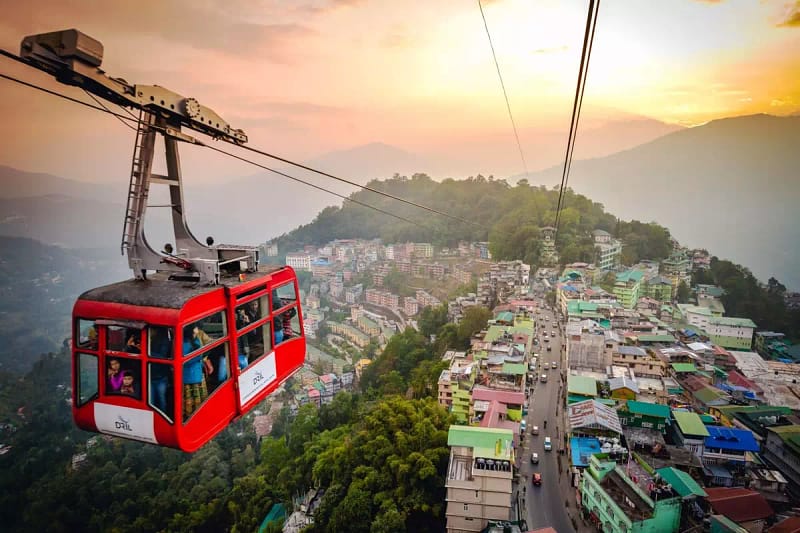
Positioned on the east of the mighty Himalayan Range, the beautiful capital city of Sikkim, Gangtok is referred to as a gateway for all kinds of tourist activities in the state of Sikkim. This charming place in northeast India is also considered one of the active tourist destinations in the state. Many tourists and travelers around the globe are attracted to this place as it is home to many beautiful mountain ranges, waterfalls, and renowned attractions. Not only that but this place also contains many exciting activities to offer such as river rafting, ropeway rides, paragliding, and many others.
In order to explore Gangtok, the best time is considered during March and May or October and mid-December. It is advised to travelers not to visit Gangtok during the monsoon season, as there is a very high possibility of landslides and heavy rainfall, which prevent the tourists from having difficulties while exploring and sightseeing.
When it comes to accommodation facilities in Gangtok there are many affordable and premium stays near the most bustling part of the city, M.G.Marg. Travelers who prefer to stay in peaceful settings can also opt to stay in hotels away from M.G Marg. The attraction points are situated in high altitudes like Nathula Pass, Tsongmo Lake, and Baba Mandir might be very challenging as there is a lack of oxygen in the air. Before visiting highly elevated places, consult a doctor and care about safety measures like inhalers, oxygen supports, and other medicines is necessary.
The domestic airport of Sikkim is Pakyong Airport, which spans over 201 acres of land making it the fifth-highest airport in India. As the airport is operational seasonally, the nearest airport to Gangtok and darjeeling is (IXB) Bagdogra Airport, West Bengal. The distance between Gangtok and Bagdogra Airport is 135km and it takes almost 3-4 hours to reach Gangtok from this airport.
Gangtok is elevated approximately at the elevation of 5,410ft and is surrounded by the 3rd tallest mountain in the world, Mt. Kanchenjunga. The most famous spot of the city is M.G. Marg which is also the first litter-free and spit-free zone of India. It is also home to the Khanchendzonga National Park, which is one of the highest national parks in India and was also inscribed in the list of UNESCO World Heritage sites. Considered the most popular Buddhist pilgrimage site it also shelters many beautiful monasteries such as the Rumtek Monastery, Phodong Monastery, and many more.
Gangtok, which contains some of the most picturesque Buddhist monasteries in India such as Rumtek and Enchey, is globally recognized as being an ideal destination for those seeking serenity and peace on an affordable budget. Its spellbound tranquility offers visitors a unique opportunity to connect themselves deeper with nature. Moreover, Gangtok boasts captivating sightseeing spots and attractions like Nathula Pass and Tsongmo Lake. Amalgamated with its rich culture and natural beauty, Gangtok provides a serene retreat for travelers in search of both spiritual rejuvenation and breathtaking landscapes.
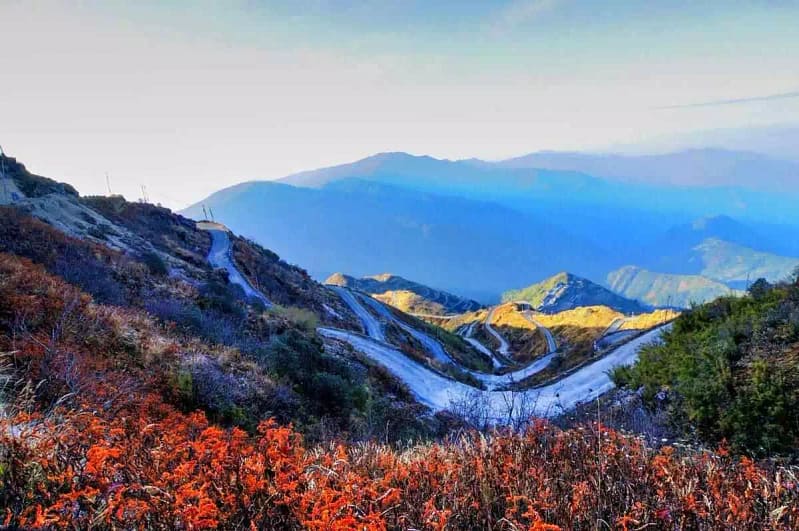
Snuggled at an altitude of 10,000ft above sea level, lies an astounding tiny hamlet of Sikkim called Zuluk. It was once the transit point of the famous “Silk Route”. This village in Sikkim is an ideal vantage point to enjoy the stunning views of Mt. Kanchenjunga. It is also renowned among bike enthusiasts for its 32 hairpin roads.
Zuluk, a spellbound destination in the state of Sikkim, gives a distinct experience to visitors at different times of the year. From August to September, it has a vibrant summer decorated with blooming flowers, creating a photogenic landscape. Simultaneously, between January and April, it changes into a winter haven with its untouched, freezing snow. Visiting this place a tourist needs a special area permit. The zig-zag roads leading to Zuluk can cause problems for visitors with such terrains and twisted turns throughout the journey. Accommodation availability is limited, with homestays being the sole choice for those looking to explore this charming village.
Dzuluk or Zuluk holds significance primarily for its breathtaking views of the eastern Himalayan mountain range making it an emerging tourist destination in Sikkim and India. It was one of the important transit points on the historic Silk Route which connected Tibet and India, Dzuluk preserves remnants of this ancient trade route that linked Lhasa (Tibet) to Kalimpong before the Chinese invasion of Tibet. The town is settled by pristine wild forests, with some areas remaining unbothered till now. Exploring this village will offer wildlife sightings, with deer, wild dogs, Himalayan bears, and even the rare red panda.
Zuluk presents an extraordinary overview of the magnificent Mount Kanchenjungha. Its various viewpoint offers visitors a beautiful and panoramic scenery of the majestic mountain. In addition to Zuluk’s beauty are its calm lakes such as the Kupup Lake, renowned as the Elephant Lake. It is also referred to among the sacred lakes of Sikkim, Kupup Lake which boasts the tranquil ambiance of the place, due to which visitors get attracted to behold its natural beauty and spiritual significance.

When it comes to exploring the beautiful land of Sikkim, Tsongmo Lake is on the “must-to-do list” of almost every backpacker. Situated at a height of almost 3,753m and 38km away from Gangtok. It is the most visited tourist attraction in Sikkim during the summer season as the quaint water of this lake reflects the giant mountain peaks covered with snow which serves as a treat to the eyes of the visitors.
It is advised to visit Tsongmo Lake during the daytime as the beautiful views of its surroundings are at its best during that time, additionally, it is a day trip from Gangtok. To explore the natural beauty and greenery of Sikkim a person needs to get a special area permit from the Sikkim Torusim department located at the M.G. Marg, Gangtok. There might be a few problems while traveling to Tsongmo Lake in the winter season as it causes many roadblocks due to heavy rainfall.
Tsongmo Lake, also commonly called Changu Lake, is surely in the list of the highest lakes in India. The lake holds a significant value to the locals as it is believed that the water of these lakes contains medical properties. Additionally, the lake’s surface reflects varying colors with the changing seasons. During the winter months, Tsongmo Lake changes into a frozen lake, creating a mesmerizing winter landscape. Moreover, it holds religious values as the lake serves as a significant venue for the Guru Poornima festival.
During the extreme cold season in november to march which is also the winters, the lake’s shoreline becomes an ideal spot for visitors to relish as they can enjoy activities like skating, yak rides, and many more. As winter ends and the summer and autumn arrive, the surroundings of the lake become vibrant with hues of Primula flowers and other alpine vegetation, which gives amazing views to the tourists. At this time of seasonal change, the lake turns into a heaven for nature lovers, drawing them to witness its picturesque landscape. Moreover, during October, bird watchers are drawn to Tsongmo Lake, eager to catch glimpses of native birds gracefully navigating the waters of the lake.
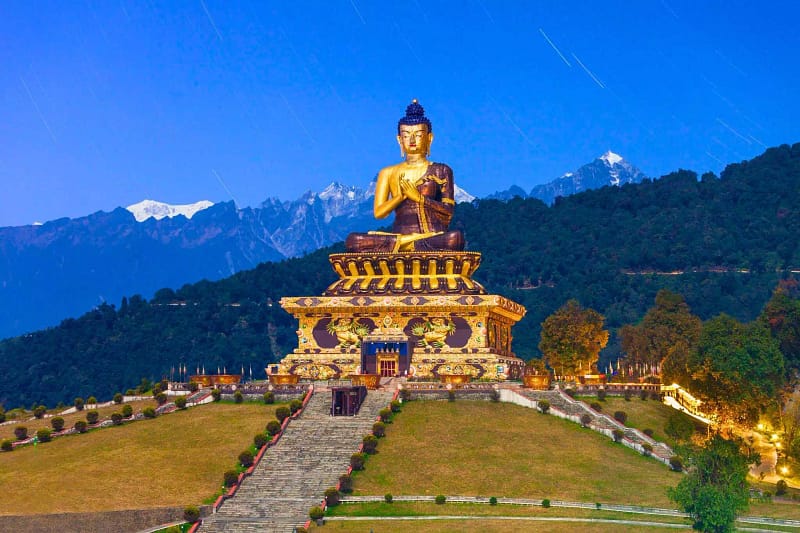
Cuddled amid the eastern Himalayas of the district of South Sikkim lies the quaint town of Ravangla. It is settled at a height of around 6,600 feet which offers a stunning panoramic view of splendid landscapes and snow-capped mountains including Mt. Kanchenjunga to the visitors. The place is also home to two natural hot springs Ralong and Boron and the peaceful atmosphere of Buddha Park commits to the town’s blissful ambiance.
The weather at Ravangla is suitable throughout the year but sometimes it may rain unexpectedly so tourists are instructed to carry raincoats and umbrellas.
The town of Ravangla turns vibrant and beautiful during the months of April and May as the flowers blossom during this time in the place. Apart from the various breathtaking views of mountain peaks, it is also famous for its diversified species of migrated birds for which many travelers from around the world pay a visit to this place.
Ravangla stands out as the Jewel of Sikkim’s landscape, the place is gifted with many things such as amazing views of mountains, pristine nature, majestic waterfalls, and many more. It is also home to one of the most iconic attractions of Sikkim which is the giant golden statue of Budhha with a mesmerizing backdrop of lush green mountains.

“The Valley of Followers” in Sikkim which is commonly known as the Yumthnag Valley is located at 3,500 meters above sea level. This stunning valley is covered with beautiful species of vibrant flowers over a lush green landscape. It also resides the astonishing Singba Rhododendron Sanctuary which consists of an extensive collection of 24 species of rhododendron plants and trees. Having a backdrop of giant surrounding mountains and the intersection with the glittering waters of the Teesta River makes it a heaven for nature lovers.
The favorable time to explore the astonishing valley of Yumthang is from the end of April to mid-June. At this time of the year, the valley blooms with vibrant flowers that look like a blanket embroidered with fine artwork, giving pleasure to the eyes of the visitors. Before traveling to the valley, a person should carry permit access for which valid identifications and two passport-sized photographs are required for the process. Due to the cold climate and the occurrence of harsh weather conditions, carrying medicines and winter clothes including a sufficient amount of cash is required as there are no proper banking options available in that area.
Few facts include about a doctor named Dr. Joseph Hooker a well-known British Botanist has compared Yumthang Valley to the majestic snow-covered valleys of Switzerland in his self-written book called “Himalayan Journal”, which emphasized the unmatched beauty of the place. Getting its name as the ‘valley of flowers,’ Yumthang is globally known for its breathtaking floral display during the spring season, which includes many Himalayan flowers like rhododendrons, poppies, primulas, cobra lilies, louseworts, and irises. Being near the China border, Yumthang Valley attracts the attention of visitors with its alpine charm and diverse botanical wonders, making it a sought-after destination for those seeking a Himalayan haven.
Located in Sikkim Yumthang Valley is a natural sanctuary, which is surrounded by fast-flowing rivers, grazing yaks, extensive meadows, and natural hot springs, these beautiful and blessed features of this place create a beautiful amalgamation of different landscapes and serene wonders.
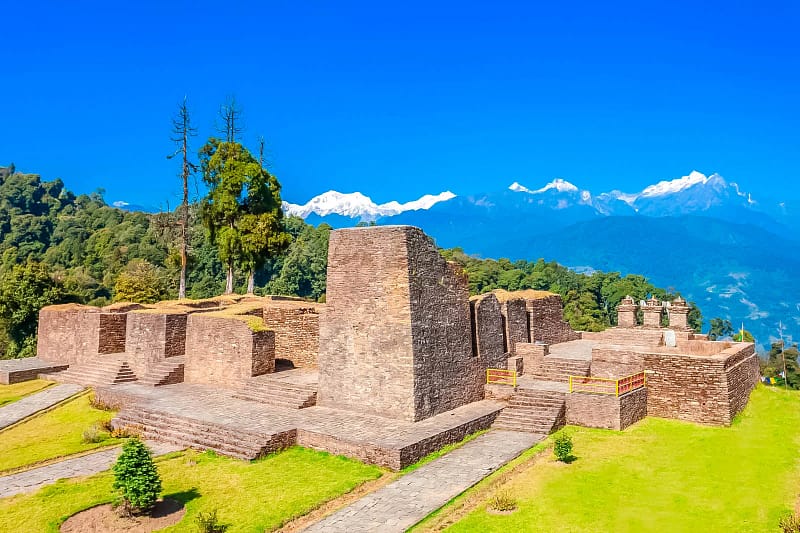
The scenic town of Pelling is well known to all backpackers and travelers around the globe for its stunning views of the eastern Himalayas and Mt. Kanchenjunga. The key attractions of these places contain attractions like Rabdentse Ruins, Khecheopalri Lake, Pemayangtse Monastery, and beautiful waterfalls. The reason it is famous for nature lovers and photographers is because it offers wonderful views of sunset and sunshine viewpoints.
The month of May and July is considered the best time to visit Pelling. The climate stays very moderate throughout our season which enables anyone to plan a trip anytime to this spectacular town in Sikkim.
Situated at 7,200ft above sea level, lying on the foothills of Himalayas and Kunchenjunga Mountain it gives and stupendous and clear view of these mountains. Being located at a high altitude it also has snowfall during the winter season. It also has a few of the oldest monasteries in Sikkim.
Pelling provides adventure enthusiasts with many beautiful trekking routes and opportunities to explore the rich flora fauna and majestic landscapes of the region as it is the base for various trekking routes. It is one of the peaceful destinations in Sikkim that offers a tranquil atmosphere. It also offers stunning views of sunrise and sunset from its various viewpoints in Pelling renowned for its breathtaking beauty, making the town a favorite of photographers and backpackers alike.

Regarded as the most scenic and beautiful tourist place in Sikkim, Lachung is a fascinating village situated in North Sikkim and covered with pristine beauty and alpine landscapes, lush greenery, and vibrant meadows. This village also boasts a significant landmark for Tibetian architecture. Lachung is also called the “Valley of Flowers” as it serves as a gateway for the astounding Yumthang Valley, which is recognized for its vibrant rhododendron, which blooms during the spring. Additionally, Lachung also is considered as a start point for mesmerizing and eye catching viewpoints like Zero Point and Katao.
Traveling to Lacung can be very difficult for travelers during the rainy monsoon season as it witnesses heavy rainfall and also in the winter season, it experiences heavy snowfall closing all the roads of the village which are crucial for its connectivity.
The mountain village of Lachung shares its boundaries with the Tibetan border which is in the northeastern part of Sikkim. It is surrounded by apple orchids and also the gateway of the rhododendron forest called Yuthang Valley which is home to various species of rhododendron species. It is so beautiful that the Joseph Dalton Hooker a renowned British botanist labeled it as the most scenic village of Sikkim in one of his written books called The “Himalayan Journal”.
The undiscovered village of Sikkim which is tucked away in the heart of the Himalayas, Lachung is praised for its awe-inspiring beauty. Even after being an unexplored Himalayan, it captivates visitors with its towering majestic mountains, winding glacial rivers, gushing waterfalls, and serene fruit orchards. The pride of Lachung lies in its beautiful landscapes, offering an escape for those seeking the charm of the untouched beauty of mother nature.
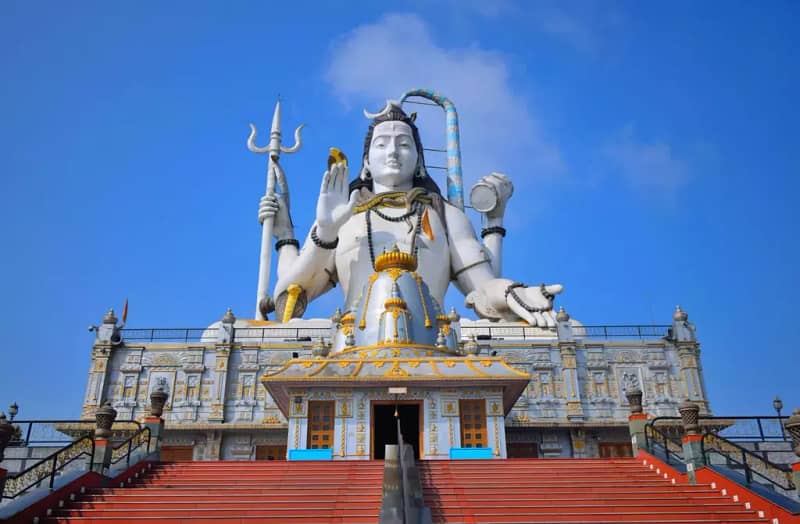
Just like many other naturally gifted places in Sikkim, Namchi also holds a reputation among the most scenic cities in the state of Sikkim. The word Nachi originated from a Tibetan word that means “Top of the Sky”. It is situated 92km away from Gangtok and sits at an altitude/height of 1,675km above sea level. Apart from being a scenic city of Sikkim, it also holds religious sentiments for both Buddhism and Hinduism as it is home to sites like Char Dham, Namchi Monastery, Tedong Hill, and Ralong Monastery.
It becomes difficult for travelers to visit Namchi during the monsoon season as the road remains slippery and muddy due to too much of landslides. Therefore the month of March and October is said to be the best time to visit Namchi.
The capital city of South Sikkim, Namchi is becoming a major tourist and pilgrimage spot. It also holds the world’s biggest statue of the Budhhist Padmasabha, the holy saint of Sikkim, which is 118 feet tall. It is also famous for its 108-foot-tall statue of lord Shiva, which many Hindu devotees come to see from all around the world.
Being one of the scenic cities of Sikkim, Namchi is also a very important place for many religious and cultural activities. During the month of October year, it hosts Namchi Mahotsav, which is regarded as one of the most popular festivals in Sikkim. Additionally, it also hosts a flower show, which displays an array of flowers from different corners of the world, boasting the rich flora and fauna of Sikkim.
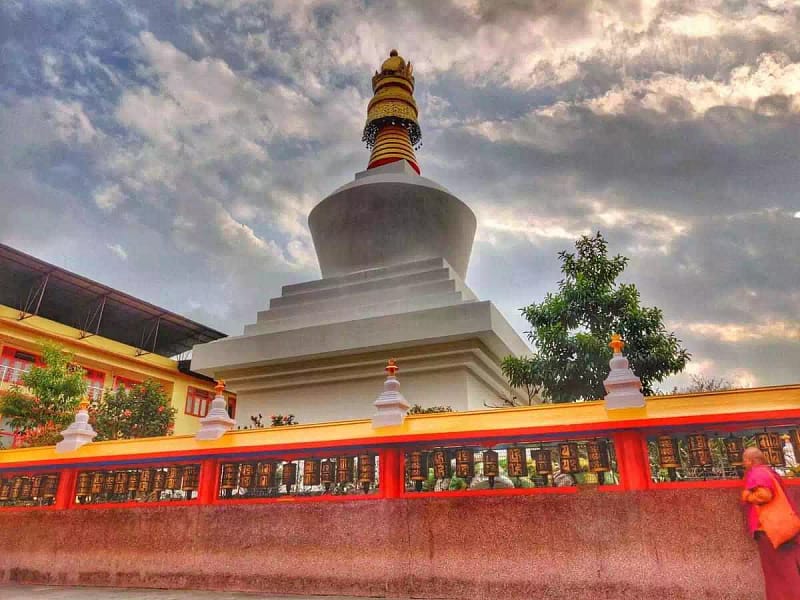
Built-in 1945 under the guidance of Truslshi Rinpoche, Do-Drul Chorten holds a strong significance and higher importance than other religious sites in Sikkim. The Stupa holds many valuable items such as holy mantra books, religious relics, and donated items from the rich and elite people, which were put inside the stupa and then laced with 108 Mani Lhakor prayer wheels.
This religious hotspot of Sikkim is located between the Nyamgyal Institute of Tibetology and the Gangtok Centre and is open all days from 8 am to 6 pm. It is best to visit this place in October and June.
After World War 2 the royal family of Sikkim was going through a tough time, hence the queen of Sikkim invited Truslshi Rinpoche who was the head of the Nyingma order of Tibetian Buddhism and build it in 1945 for the wellbeing of their family and countrymen. It is surrounded by 108 mantra wheels and the complex of this place houses around 700 Buddhist monks.
Do-Drul Chorten is a religious place in Sikkim that holds a rich history of the monarchy and Buddhism in Sikkim. It is also quite famous among photographers as well.
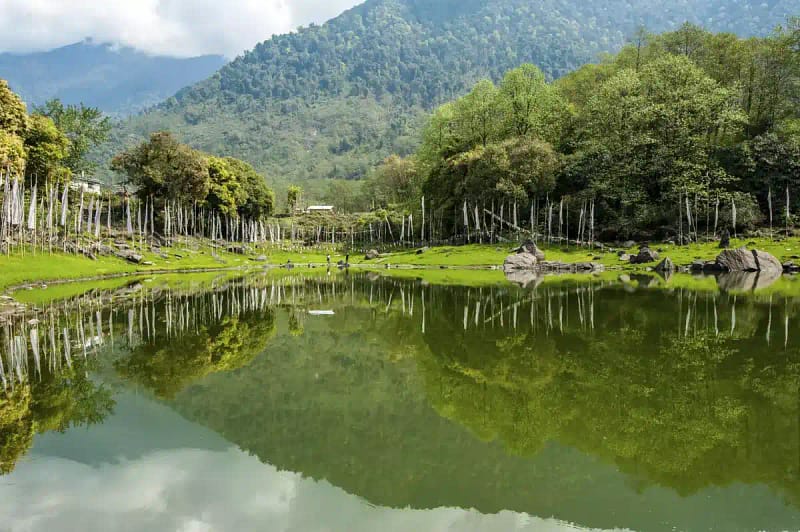
Situated in the west of Sikkim, Yuksom which operated as the capital city of Sikkim during bygone times serves as the gate for many of the most popular treks into the Himalayas and the enchanting Kanchenjunga region. This serene hamlet of Sikkim is renowned for its unbothered beauty and rustic charm. Yuksom also known as the “Meeting Place of Three Lamas”, has one the oldest mysteries of its state also due to its majestic landscapes and panoramic views of its alluring greenery it has stood out and gained the attention of tourists from all over the world.
The weather in Yuksom is generally very soothing and pleasant, which is due to the ideal geographical location at a moderate altitude. Between the months of March to June and September to October, is mostly consired as the one of best time to visit this place, infact the best by almost all local guides. There is a good transportable road at Yuksom, but sometimes during the monsoon season, it becomes troublesome for travelers to commute by public transport.
Yuksom is considered the land, where the first king of Sikkim was coronated in 1642. It was also the first capital city of the state of Sikkim during the 17th century. The place also comprises many historical sites and ancient Buddhist monasteries, one of which is the Dubdi Monastery, which was made in 1701.
Yuksom is regarded as an ideal gateway to Mt. Kanchendzongha because this spellbinding historical town boasts the breathtaking beauty of nature. This place is filled with an array of magnificent waterfalls and is adorned with numerous enchanting trails, making visitors restless enough to explore it. The main attractions of Yuksom encompass historical monuments, ancient monasteries, tranquil waterfalls, and serene lakes. This charming destination attracts travelers for its rich history and natural splendor, creating a perfect setting for a memorable and peaceful retreat.

Home to more than a thousand species of exotic and rare species of plants and trees, the Jawaharlal Nehru Botanical Garden is a must-visit itinerary for every Sikkim tour package. Covered with lush green expansive land and beautiful fountains, this amazing place in Sikkim leaves tourists spellbound. The place provides activities for people of all ages, giving tourists spend quality time with their loved ones.
Situated 22km away from Gangtok it lies on the same way as the Rumtek Monastery. It stays open for all the days from 8 am to 6.30 pm and the fee to enter for adults is 10 rupees and for children, it is 5 rupees. The rush time of tourists at this place begins between March to May, which is the blooming season that turns the place completely vibrant, and then during October and mid-December, as the nearby surroundings turn scenic with snow-capped mountains and valleys.
Jawaharlal Nehru Botanical Garden was inaugurated in the year 1987. The huge array of flora and fauna has an estimated height range of 1800m to 2200m. These botanical gardens in Sikkim not only have a huge collection of almost 1.5 lakhs of plants but also have a collective cluster of Oak trees as well.
The Jawaharlal Nehru Botanical Garden possesses an affluent multiplicity of plants and trees, featuring various species of orchids and over 50 different types of trees, which also include various oak trees. Being situated on a hilltop, its location offers an unparalleled viewpoint to the visitors to behold the scenic city of Gangtok, with a spell-bounding backdrop of the mighty Himalayan Mountains. Moreover, it also provides an amazing experience for children, as it offers a range of recreational activities such as merry-go-rounds, swings, and see-saws, ensuring a joyous time for young visitors.

Feel the peaceful ambiance and true essence of religious awakening as you step inside the oldest and among the biggest monasteries in the state of Sikkim, Rumtek Monastery. The monastery which is also known and consired as the name of Dharma Chakra Centre holds one of the rarest religious Buddhist artifacts and is also renowned for Kargyu Teachings. It is an ideal spot for travelers who want to seek the beauty of nature and spirituality at the same time.
Rumtek Monastery is located almost 21.8 km away from Gangtok, and it was inaugurated in the year of 1966 by the 16th Karmapa. The monastery stays open between 9 am to 6 pm. To watch the monks residing within the monastery, it is advised that tourists reach there as early as possible. It also strictly prohibited visitors from doing any kind of filming and photography inside the monastery.
This holy monastery a religious landmark in Sikkim was once the home of his holiness The Gwayla Karmapa Kargyu. The amazing and historical architecture of the monastery has been contained in the most beautiful monasteries in India and it resembles the Tsurphu Monastery in Tibet. Rumtek Monastery also contains unique and rare artworks from 1001 and numerous golden miniatures of Lord Buddha, Thangkas, and wall murals which were brought in the year 1963 by the 16th Karmapa, Rangjung Ringpe Dorje.
Enjoy the amazing surroundings of the Rumtek Monastery covered with lush green mountains giving you an aesthetic and spiritual experience. Get to learn about the history of Buddhism by having a close look at the ancient artifacts, religious objects, and manuscripts.

Towered at an altitude of 4310 meters above sea level the Nathula Pass was once part of the famous “Silk Road”, it is amongst the highest motorable passes in the world. Nathula Pass also serves as an important bridge between Tibet and Sikkim. Accessible to Indian nationals, a visit to this remarkable pass requires permission from the tourism department. However, for foreign nationals, reaching Nathu La is not an option due to restrictions.
Nathula Pass remains closed on Mondays, Tuesdays, and Fridays, and during the winter season this place is very difficult to visit because of heavy snowfall where the temperature goes below -25°C. The zigzag road patterns of the pass also cause motion sickness which is another disadvantage for travelers. It is advised to carry medicines for the ones who are prone to such difficulties. A special area permit, requiring photo identity proof and two passport-sized photos, is mandatory for visiting. This permit can be obtained from the zonal office or arranged through a travel agent. Notably, photography is prohibited at Nathula Pass.
It is classified as the highest motorable pass in the world and has been a significant part of ancient times as it was part of the “Silk Route” and played a major role in trade between China, Tibet, and India. It also connects Sikkim with China.
Nathula Pass offers tourists a pleasing view of the picturesque Chumbi Valley in Tibet, along with the gigantic snow-covered mountains. The journey through the hills holds its own charm, often surpassing the delight of reaching the destination itself. This holds true for Nathula Pass, where driving on roads flanked by snow-laden landscapes offers a truly immersive experience. The beauty that surrounds the route enhances the joy of the drive, creating a memorable journey through this scenic terrain.
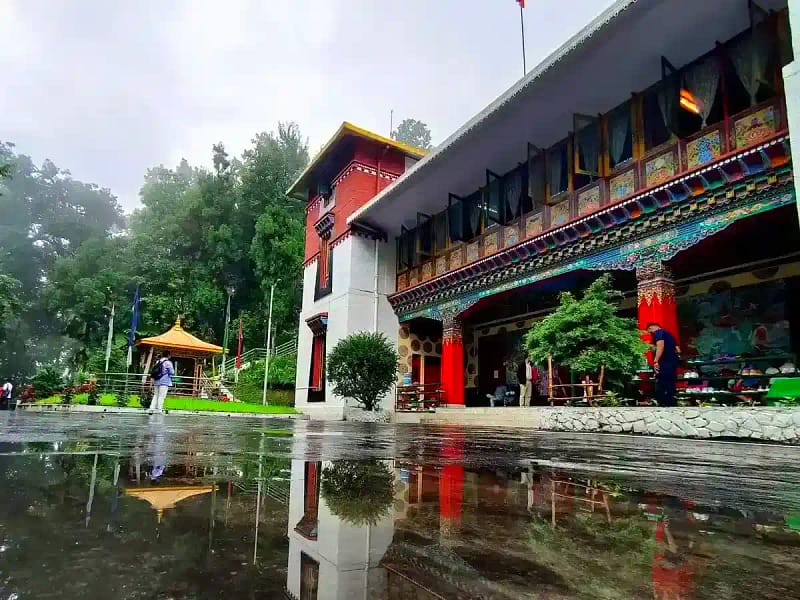
Just 2.2km away from the center of Gangtok lies one of the well-known institutions in Sikkim, the Namgyal Institute of Tibetology. It was established in 1958 and was named after the 11th King of Sikkim, Palden Thondup Namgyal, and is based on the study and research that focuses on Tibetan culture, Buddhism, and its history. Its amazing architectural style boasts the traditional Tibetan design as well and it holds some features of Sikkimese architecture, not just that it also houses many rare Tibetan and Sanskrit manuscripts, statues, and thangkas (Tibetan traditional scroll paintings), promoting Tibetan culture and its heritage in India.
Namgyal Institute of Tibetology is located in Gangtok and the time to visit it is from 10 am to 4 pm from Monday to Saturday.
Namgyal Institute of Tibetology Facts The late Indian Prime Minister Pandit Jawaharlal Nehru laid the foundation stone for the Namgyal Institute of Tibet on October 1, 1958, with the 14th Dalai Lama leading the ceremony. As days went by the institute expanded its academic offerings, adorned by the establishment of the Department for the Study of Tibetan Medicine also known as BSRMS in 2018.
The Namgyal Institute of Tibetology is distinguished by its remarkable Sikkimese architecture, a striking feature that adds to its cultural and aesthetic appeal. The institute’s design reflects the traditional architectural style of Sikkim, contributing to its unique identity in the region. Beyond its architectural charm, the institute is enveloped by lush landscapes, surrounded by verdant forests dominated by oak and birch trees. This natural setting not only enhances the tranquil ambiance of the institute but also provides an inviting environment for scholars, researchers, and visitors to experience the true essence of spirituality and the serene beauty of the Himalayan foothills.

Named after the famous Buddhist saint Padmasambhava, this place holds a prominent significance for both Hindus and Buddhists. This lake is nestled at an elevation of about 17,800 ft. Covered by the majestic Himalayas this lake is one of the highest lakes in the world. It offers visitors an astonishing view of snow-capped mountains including Mt. Kanchenjunga. It is also a pilgrimage site which makes it unique from other destinations on the terrains of Sikkim.
Due to its location being on an extreme elevation of 5,430 meters above sea level, travelers who have breathing or any kind of respiratory problems are suggested to not enter this air, as there is very little amount of oxygen in the air. Before moving to the lake it is advised to do a check-up by a doctor and one should not smoke and carry warm clothes before travelling to the lake. Between the months of mid-December to January (Winter Season) the roads are blocked due to extreme snowfall. Tourists also need to get a special permit to enter this place as it is close to the Chinese border.
Gurudongmar Lake is considered one of the highest natural lakes in the world. During the winter the lake turns completely frozen as the temperature drops below -20°C. It is also said that the water of this lake contains properties that heal the fertility of women.
To get a surreal view of the Gurudongbar Lake it is suggested to visit the place during the summer season, between April and May as the nearby areas witness the flowering season making it a painting straight out of the Canva of a beautiful painting.
The most beautiful parts of Sikkim are Gurudongma Lake, Tsongmo Lake and Yuksom
Popular places to visit in Sikkim include Gangtok, Pelling, Namchi, Lachung, Ravangla, Lachen, Rangpo, and Mangan
3 days are not enough to explore Sikkim fully. However, you can cover some of the popular places in Sikkim like Gangtok, Lachung, and Yumthang Valley in 3 days
Sikkim is best known for its natural beauty, biodiversity, ancient monasteries, vibrant festivals, and warm-hearted locals
The best time to visit Sikkim is from March to June and from September to December
Sikkim is not an expensive destination to travel to, but prices are a little bit on the higher side considering the altitude it is in.
West Sikkim is known for its beautiful views of the Southeast face of Mt. Kangchenjunga
East Sikkim boasts of some of the greatest scenic locations like Tsomgo lake, Nathula pass, Tukla Valley, Zuluk, and Jelep La pass
Zero Point is located in the northern region of Sikkim, only 15 km from Lachung Valley
Zero Point is situated in the northern region of Sikkim
The famous food of Sikkim is momos, taipo, thupka
The famous fruit in Sikkim is Kiwi
Share This Article

At GoFlySmart Holidays, we strive to provide a seamless and stress-free booking experience. Our state-of-the-art technology enables travel agents & customers to Read More…
Call Us
9735444333
Email for Us
[email protected]
Email Us
Ut enim ad minim veniam, quis nostrud exercitation ullamco laboris nisi ut aliquip ex ea commodo consequat. Duis aute irure dolor in reprehenderit in